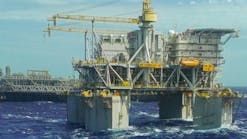Chevron continues as directional leader
Marty Lingner, David JurgensDirectional drilling operations in the US Gulf of Mexico are projected to remain at 1,525 wells for the 12 months of 1998, equaling the record number of such wells drilled in 1997. Projections are based upon past drilling efforts and estimates of activity from operators.
Energy Graphics
Because of changes and shifts in industry activity as a result of the low price downturn, projecting a number for 1999 will have to wait operator activity in the first months of 1999.
The number of directional wells leaped 300 wells, to a total of 1,289 wells, in 1996, and leaped another 200 plus wells in 1997, to set new industry records. This number of directional wells is calculated from a total of 1,858 and 1,860 wells of all types drilled in 1997 and 1998, respectively. The previous high in directional wells was 1,161 set in 1984.
The past 10 years began with directional wells in the Gulf of Mexico having re covered to the 800-900 well range from lows
in 1986-1987. This was still well below the 1,100-1,200 level seen in the period between 1976-1985.
Between 1991-1993, however, wells dipped down again, this time to below 500 in 1992, a level not seen since 1964. By 1995, directional drilling had pushed into the 1,100 well range once again.
Directional leaders
Drilling in the Gulf of Mexico from 1996-1998 continued to be led by some of the same five or six companies as in previous years (see table on top companies completing directional wells). Chevron topped the list in all three years followed by Shell in 1996 and 1997, with Vastar leaping into second in 1998. Exxon actually surpassed Unocal in 1997 with 61 wells, but drilled less than Unocal for the other two years.The Central Gulf of Mexico continued to be the most popular area for exploration with Eugene Island, South Timbalier, and Ship Shoal having the highest three-year averages in that order (see table on most active areas).
In 1998 alone, West Cameron South and Vermilion saw increased activity, bringing them into the number two and number three spots for last year (see table for drilling results). The figures in this table were taken from the complete EGI well database, which includes both directional and straight holes.
An accompanying table on maximum inclination angle shows the distribution of wells by maximum closure distance for all of the wells in the Gulf of Mexico directional survey database. A close-up of the wells exceeding 95 degrees is inserted to show two wells that extended the maximum closure distance past 100 degrees.
Closure distance
The first was the Texaco Exploration & Production Company #A21ST3 in Eugene Island S. Addn. Blk. 338 which was drilled to a measured depth of 8,320 ft and a true vertical depth (TVD) of 6,840 ft in May of 1993. The maximum angle of the well was 105.6 degrees.The second well was drilled by Shell Offshore, Inc. The well, #D40ST2, was completed in South Pass Blk. 61 in March 1995 to a measured depth of 8,887 ft., with a TVD of 6,347 ft, and a maximum angle of 100.4 degrees.
Since there is a two-year grace period allowed operators by MMS before directional surveys are released to the public, Energy Graphics has actual directional survey data for wells drilled in the gulf through December 31, 1996.
Figures for 1997 and 1998 have been obtained primarily using the EGI well database and have been projected based on a reasonably consistent historical average of 82% for directional wells to total wells drilled each year.
Authors
Marty Lingner is the Database Manager at Energy Graphics. She is responsible for maintaining all databases.
David Jurgensis the Unix Group Manager for Energy Graphics. He manages Unix program development and software enhancement.
Copyright 1999 Oil & Gas Journal. All Rights Reserved.









